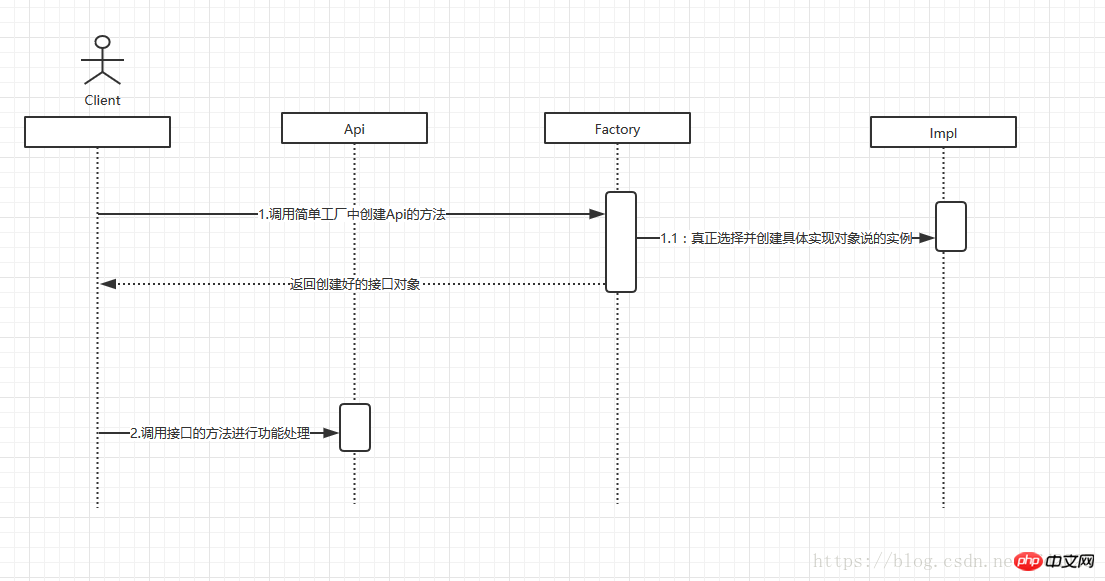Detailed explanation of PHP's simple factory pattern
This article mainly shares with you a detailed explanation of PHP's simple factory mode. It has a good reference value and I hope it will be helpful to everyone. Let’s follow the editor to have a look.

1. Definition of simple factory
Provides a function to create object instances without having to worry about its specific implementation , the type of the instance being created can be an interface, an abstract class, or a concrete class.
2. The structure and description of a simple factory
The structure of a simple factory is as follows:
- ##Api: Define the functional interface required by the customer
- Impl: Specifically implement the implementation class of Api, there may be multiple
- Factory: Factory, select the appropriate implementation class to create the Api interface object
- Client: Client, obtain the Api interface object through Factory, and then program for the Api interface
/**
* 接口的定义,该接口可以通过简单工厂来创建
*
* @author Administrator
*
*/
public interface Api {
/**
* 具体功能方法的定义
*
* @param s
* 需要的参数
*/
public void operation(String s);
}
/**
* 接口的具体实现对象A
*
* @author Administrator
*
*/
public class ImplA implements Api {
@Override
public void operation(String s) {
// 实现的功能
System.out.println("ImplA s==" + s);
}
}/**
* 接口的具体实现对象B
*
* @author Administrator
*
*/
public class ImplB implements Api {
@Override
public void operation(String s) {
// 实现的功能
System.out.println("ImplB s==" + s);
}
}
/**
* 工厂类,用来创建Api对象
*
* @author Administrator
*
*/
public class Factory {
/**
* 具体创建Api对象的方法
*
* @param condition
* 从外部传入的选择条件
* @return
*/
public static Api createApi(int condition) {
// 应该根据某些条件去选择究竟创建哪一个具体的实现对象
// 这些条件可以从外部传入,也可以从其他途径获取
// 如果只有一个实现,可以省略条件
Api api = null;
if (condition == 1) {
api = new ImplA();
} else if (condition == 2) {
api = new ImplB();
}
return api;
}
}
public class Client {
public static void main(String[] args) {
// 通过简单工厂来获取接口对象
Api api = Factory.createApi(1);
api.operation("正在使用简单工厂模式");
}
}
Simple factory calling sequence diagram:

Naming suggestions for simple factories:
- Class naming suggestions are "Module name + Factory", for example, the factory of the user module is called UserFactory
- The method name is usually "get+interface name" or "create+interface name". For example, if the user interface name is UserEbi, then the method name is usually getUserEbi or createUserEbi.
- The main internal function of a simple factory method is "
Select the appropriate implementation class". The selection condition or the source of the parameter is usually Focus on the following:
- comes from the client, and the parameters are passed in by the Client.
- comes from the configuration file, and is obtained from the configuration file. The judged value
- comes from a certain value during the program's running time, such as obtaining a certain running-time value from the cache
Advantages of simple factory:
- Help encapsulation
- Although simple factory is simple, it is very friendly It helps us realize the encapsulation of components, and then allows the outside of the components to truly interface-oriented programming.
2. Decoupling
Through a simple factory, the client and the specific implementation class are decoupled.
Disadvantages of simple factories: 1. May increase the complexity of the client
2. Inconvenient to expand sub-factories
The essence of a simple factory: choosing an implementation
When to choose a simple factory:
- If you want to completely encapsulate and isolate the specific implementation, so that the outside can only operate the package through the interface, then you can choose a simple factory to let the client obtain the corresponding interface through the factory without caring. specific implementation.
- If you want to centrally manage and control the responsibilities of creating external objects, you can choose a simple factory.
The above is the detailed content of Detailed explanation of PHP's simple factory pattern. For more information, please follow other related articles on the PHP Chinese website!

Hot AI Tools

Undresser.AI Undress
AI-powered app for creating realistic nude photos

AI Clothes Remover
Online AI tool for removing clothes from photos.

Undress AI Tool
Undress images for free

Clothoff.io
AI clothes remover

AI Hentai Generator
Generate AI Hentai for free.

Hot Article

Hot Tools

Notepad++7.3.1
Easy-to-use and free code editor

SublimeText3 Chinese version
Chinese version, very easy to use

Zend Studio 13.0.1
Powerful PHP integrated development environment

Dreamweaver CS6
Visual web development tools

SublimeText3 Mac version
God-level code editing software (SublimeText3)

Hot Topics
 1378
1378
 52
52
 PHP 8.4 Installation and Upgrade guide for Ubuntu and Debian
Dec 24, 2024 pm 04:42 PM
PHP 8.4 Installation and Upgrade guide for Ubuntu and Debian
Dec 24, 2024 pm 04:42 PM
PHP 8.4 brings several new features, security improvements, and performance improvements with healthy amounts of feature deprecations and removals. This guide explains how to install PHP 8.4 or upgrade to PHP 8.4 on Ubuntu, Debian, or their derivati
 How To Set Up Visual Studio Code (VS Code) for PHP Development
Dec 20, 2024 am 11:31 AM
How To Set Up Visual Studio Code (VS Code) for PHP Development
Dec 20, 2024 am 11:31 AM
Visual Studio Code, also known as VS Code, is a free source code editor — or integrated development environment (IDE) — available for all major operating systems. With a large collection of extensions for many programming languages, VS Code can be c
 How do you parse and process HTML/XML in PHP?
Feb 07, 2025 am 11:57 AM
How do you parse and process HTML/XML in PHP?
Feb 07, 2025 am 11:57 AM
This tutorial demonstrates how to efficiently process XML documents using PHP. XML (eXtensible Markup Language) is a versatile text-based markup language designed for both human readability and machine parsing. It's commonly used for data storage an
 PHP Program to Count Vowels in a String
Feb 07, 2025 pm 12:12 PM
PHP Program to Count Vowels in a String
Feb 07, 2025 pm 12:12 PM
A string is a sequence of characters, including letters, numbers, and symbols. This tutorial will learn how to calculate the number of vowels in a given string in PHP using different methods. The vowels in English are a, e, i, o, u, and they can be uppercase or lowercase. What is a vowel? Vowels are alphabetic characters that represent a specific pronunciation. There are five vowels in English, including uppercase and lowercase: a, e, i, o, u Example 1 Input: String = "Tutorialspoint" Output: 6 explain The vowels in the string "Tutorialspoint" are u, o, i, a, o, i. There are 6 yuan in total
 Explain JSON Web Tokens (JWT) and their use case in PHP APIs.
Apr 05, 2025 am 12:04 AM
Explain JSON Web Tokens (JWT) and their use case in PHP APIs.
Apr 05, 2025 am 12:04 AM
JWT is an open standard based on JSON, used to securely transmit information between parties, mainly for identity authentication and information exchange. 1. JWT consists of three parts: Header, Payload and Signature. 2. The working principle of JWT includes three steps: generating JWT, verifying JWT and parsing Payload. 3. When using JWT for authentication in PHP, JWT can be generated and verified, and user role and permission information can be included in advanced usage. 4. Common errors include signature verification failure, token expiration, and payload oversized. Debugging skills include using debugging tools and logging. 5. Performance optimization and best practices include using appropriate signature algorithms, setting validity periods reasonably,
 7 PHP Functions I Regret I Didn't Know Before
Nov 13, 2024 am 09:42 AM
7 PHP Functions I Regret I Didn't Know Before
Nov 13, 2024 am 09:42 AM
If you are an experienced PHP developer, you might have the feeling that you’ve been there and done that already.You have developed a significant number of applications, debugged millions of lines of code, and tweaked a bunch of scripts to achieve op
 Explain late static binding in PHP (static::).
Apr 03, 2025 am 12:04 AM
Explain late static binding in PHP (static::).
Apr 03, 2025 am 12:04 AM
Static binding (static::) implements late static binding (LSB) in PHP, allowing calling classes to be referenced in static contexts rather than defining classes. 1) The parsing process is performed at runtime, 2) Look up the call class in the inheritance relationship, 3) It may bring performance overhead.
 What are PHP magic methods (__construct, __destruct, __call, __get, __set, etc.) and provide use cases?
Apr 03, 2025 am 12:03 AM
What are PHP magic methods (__construct, __destruct, __call, __get, __set, etc.) and provide use cases?
Apr 03, 2025 am 12:03 AM
What are the magic methods of PHP? PHP's magic methods include: 1.\_\_construct, used to initialize objects; 2.\_\_destruct, used to clean up resources; 3.\_\_call, handle non-existent method calls; 4.\_\_get, implement dynamic attribute access; 5.\_\_set, implement dynamic attribute settings. These methods are automatically called in certain situations, improving code flexibility and efficiency.




